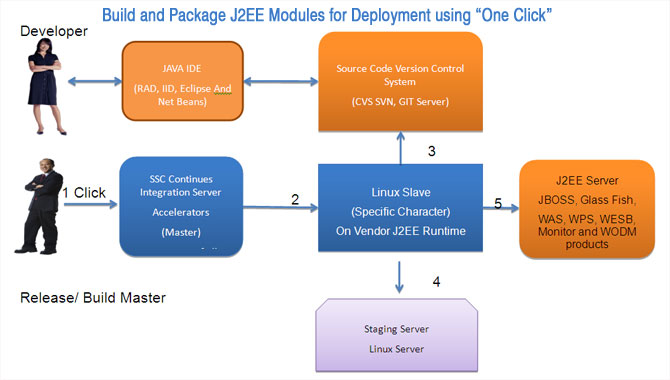Development Accelerators
Continuous integration (CI) is the practice, in software engineering, of merging all developer workspace with a shared mainline several times a day. It was first named and proposed as part of extreme programming (XP). Its main aim is to prevent integration problems, referred to as "integration hell" . CI can be seen as an intensification of practices of periodic integration advocated by earlier published methods of incremental and iterative software development, such as the Booch method

Development Accelerators reduces the risks
By integrating our accelerators, you can reduce risks on your project. Doing so facilitates the detection of defects, the measurement of software health, and a reduction of assumptions.
- Defects are detected and fixed sooner - Development accelerators integrates and runs tests and inspections several times a day, there is a greater chance that defects are discovered when they are introduced (i.e., when the code is checked into the version control repository) instead of during late-cycle testing.
- Health of software is measurable - Our accelerators introduces continuous testing and inspection into the automated integration process which enables to monitor the software product's health attributes, such as complexity, can be tracked over time.
- Reduce assumptions - By rebuilding and testing software in a clean environment using the same process and scripts on a continual basis, you can reduce assumptions (e.g., whether you are accounting for third-party libraries or environment variables).
Development Accelerators reduces repetitive processes
Accelerators reduce the repetitive process across all project activities, including code compilation, testing, inspection, and deployment. Helps in
- The reduction of labor on repetitive processes, freeing people to do more thought-provoking, higher-value work
- The capability to overcome resistance (from other team members) to implement improvements by using automated mechanisms for important processes such as testing and database integration
Development Accelerators generates deployable software
Our accelerators enable you to release deployable software at any point in time. From an outside perspective, this is the most obvious benefit of our accelerators. With our accelerators, you make small changes to the source code and integrate these changes with the rest of the code base on a regular basis. If there are any problems, the project members are informed and the fixes are applied to the software immediately. Projects that do not embrace this practice may wait until immediately prior to delivery to integrate and test the software. This can delay a release, delay or prevent fixing certain defects, cause new defects as you rush to complete, and can ultimately spell the end of the project.
Development Accelerators enables better project visibility
Our accelerators provide the ability to notice trends and make effective decisions, and it helps provide the courage to innovate new improvements. Typically, project members collect this information manually, making the effort burdensome and untimely. The result is that often the information is never gathered. Our Continues Integration accelerators have the following positive effects.
- Effective decisions – System provide just-in-time information on the recent build status and quality metrics.
- Noticing trends - the ability to notice trends in build success or failure, overall quality, and other pertinent project information becomes possible.
Development Accelerators establishes greater product confidence
Our Development accelerators provide greater confidence in producing a software product. With every build, your team knows that tests are run against the software to verify behavior, that project coding and design standards are met, and that the result is a functionally testab.
Sripathi Solutions accelerators will deploy a template driven approach to enable the adoption of CI best practices building and deploying the various IBM components ( WPS modules, WESB modules, SCA Modules, WODM Modules and BPM artifacts) and J2EE components.
